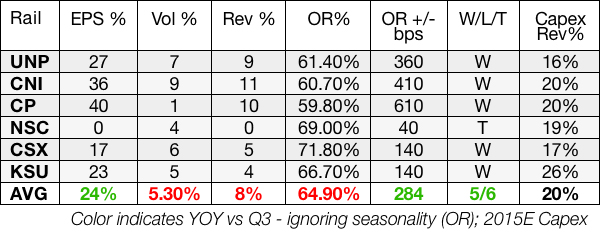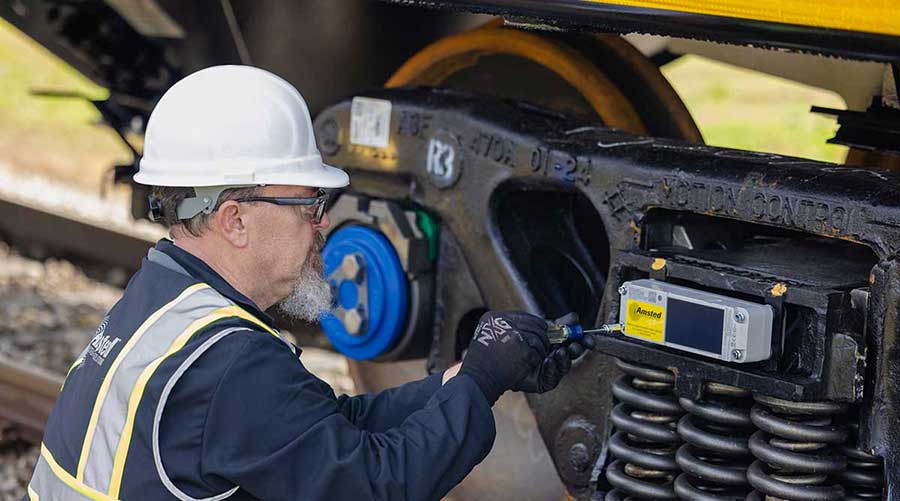Stay updated on news, articles and information for the rail industry
February 2015
Rail News: Rail Industry Trends
Class I railroads in context: They're trending in the right direction
By Tony Hatch
Sometimes I get accused of being too bullish, or too optimistic, about the Class I railroad group. That looked to be the case last winter and spring, as service issues really called the “rail renaissance” concept into question. In my defense, I can be a harsh critic on the service front, as my shipper friends will allow — and I follow railroad capex trends closely. The only thing that can really disrupt the ongoing and powerful renaissance is execution: service, capacity, the Grand Bargain with shippers and safety.
To that end, the recent crude-by-rail (CBR) incidents highlighted to those in the know the fact that the rails executed 500,000 carloads last year with but seven incidents, although any one could be damaging. (To the public? Perhaps something else again.) Of course, there's the potential for (re)regulation, with the latter very much tied to rail execution.
In terms of service recovery and capacity availability/fluidity, it now seems that the combination of management focus (hearing those “squeaky wheels”), the expenditure of a lot of money and a more typical winter so far (vs. last year's) has turned around the great ship. Class I service metrics are trending in the right direction, congestion has been reduced and Chicago is working … as well as Chicago can.
Financially, the rails had a very good quarter in Q4 2014, despite some headwinds, both real (the self-imposed lingering congestion, weak exports and foreign exchange [FX]), and imagined (crude by rail) as the individual company earnings reports show. The chart below shows the major rails Q4/14 performance — note that Genesee & Wyoming (GWR) and BNSF (Berkshire Hathaway, perhaps due to report in early March) are omitted. Year-over-year (YOY) earnings accelerated in Q4 despite a very slight drop in volume and revenue growth as pricing was stronger, as expected. All of the rails showed margin improvement. And, all of them increased capex, as well.
“It ain’t bragging if it’s true” is an old Dizzy Dean phrase that I recall when I think that the rails have:
1. Beaten the market every year since 2000 (the rail renaissance). An extended bull run that is not yet over.
2. The rails have shown consistent revenue and earnings growth that are faster than the market's. One reason they outpace the stock market is growing appreciation for the rails’ growth achievement and potential above that of a “merely cyclical” industry. Railroads have shown secular growth (intermodal) and real flexibility (energy), as well as the defensive characteristics of their diverse volume base — not to mention the proven productivity opportunity. Q4 2014 earnings per share growth YOY to date is 24 percent, perhaps three to four times the final S&P 500 earnings tally.
3. Railroads have consistently beaten the Street estimates during the entire renaissance, despite supposed rising bullishness, successful recent history and the model modification capability coming from weekly traffic and service numbers. In Q4, five of the six Class Is beat consensus estimates (CSX “tied”); counting GWR, five of seven overall. I would wager that BNSF will, too, once we drill down into the numbers next month. The average earnings growth margin over consensus was 7 percent.
Here are the Q4 themes, based on financial results and conference-call conversation:
1. Oil, Oi! Oi! Oi! Was there ever a bigger topic in a quarter? Will lower oil prices hurt rails? Universally, rails have said no.
CBR/sand combined are below 5 percent of the total of volumes and revenues, even if it seems to take up 95 percent of the public discussion. Admittedly, it is a higher percentage of consensus estimated growth, or was prior to the price collapse; but rails, as always, are defended by a broad and diverse traffic base. And much of that traffic base benefits from lower oil prices — see intermodal, automotive, housing related, etc. In January, consumer spent at their fastest pace in 10 years; auto sales boomed, with larger vehicles leading the way; job growth began to return. This is a bad scenario?!?
Despite the fears, and as rail management stressed, the decline in the price of diesel — much less than the decline in the price of oil price — will not cause major modal shifts in intermodal or merchandise traffic. The rails will not lose much, if any, share to truck for diesel price reasons. Trucking is burdened by its own capacity issues and is still priced 10 percent to 40 percent higher than rail.
Meanwhile, it is far from clear that the CBR story is “over” — for example, production will be up this year, although perhaps not as much as thought six months ago. The U.S. Energy Information Administration called the North American shale “party” merely “paused,” and still estimates a 50 percent increase in U.S. output by 2020! Pending issues that may (or may not) arise from the recent derailments, I think that CBR is here to stay; it just must be placed in the same “volatile” category with export grain.
2. The Street seems unduly obsessed not only by oil but by accounting issues — FX, fuel surcharges, pensions — rather than core earnings power. Admittedly, FX issues can impact shipper competitive advantages or disadvantages within North America (for example, Canadian vs. U.S. lumber) or globally (U.S vs. Australian wheat).
3. The second half of the year and 2016 appear to be emerging as a concern. The rails didn’t give the most electrifying set of near-term outlooks, with lower revenue growth forecasts and headwinds a consistent theme. But pricing will be strong, the economy is contributing and productivity numbers will be accelerating — don’t believe the lack of hype!
4. Looking beyond the stale calls, we can see the quality. Operating ratio targets were maintained or boosted for those that gave guidance, notably CSX and Canadian Pacific. There also were share buybacks and dividend increases (25 percent at CN!).
5. Service trends clearly are improving — itself a huge YOY savings in cost (excluding the revenue and share impacts of improvement). The service recovery pattern also has reduced if not eliminated the threat of significant government intervention. Let’s see what the CBR incident in West Virginia does, but open access et. al is far more dangerous to the renaissance than new tank cars. Also: Class I capex is up 5 percent for 2015, a sign of confidence and future improvements in fluidity and capacity, although I have some concerns about the growing capex gap in the West. Ultimately, I expect rail pricing to improve from below 3 percent to 4 percent in 2015, with domestic intermodal on the verge of bigger numbers.
6. M&A on the back burner again at last? But “activist” funds are growing in importance in the marketplace, with The Economist noting the biggest issue was “the paucity of prey” — enough warning to send shivers down many a board member!
Tony Hatch is an independent transportation analyst and consultant, and a program consultant for Progressive Railroading's RailTrends® conference. Email him at abh18@mindspring.com.
Keywords
Browse articles on Class I railroad rail renaissance crude by rail railroad capex Tony HatchContact Progressive Railroading editorial staff.


 2025 MOW Spending Report: Passenger-rail programs
2025 MOW Spending Report: Passenger-rail programs
 Gardner steps down as Amtrak CEO
Gardner steps down as Amtrak CEO
 Guest comment: Oliver Wyman’s David Hunt
Guest comment: Oliver Wyman’s David Hunt
 Women of Influence in Rail eBook
Women of Influence in Rail eBook
 railPrime
railPrime







